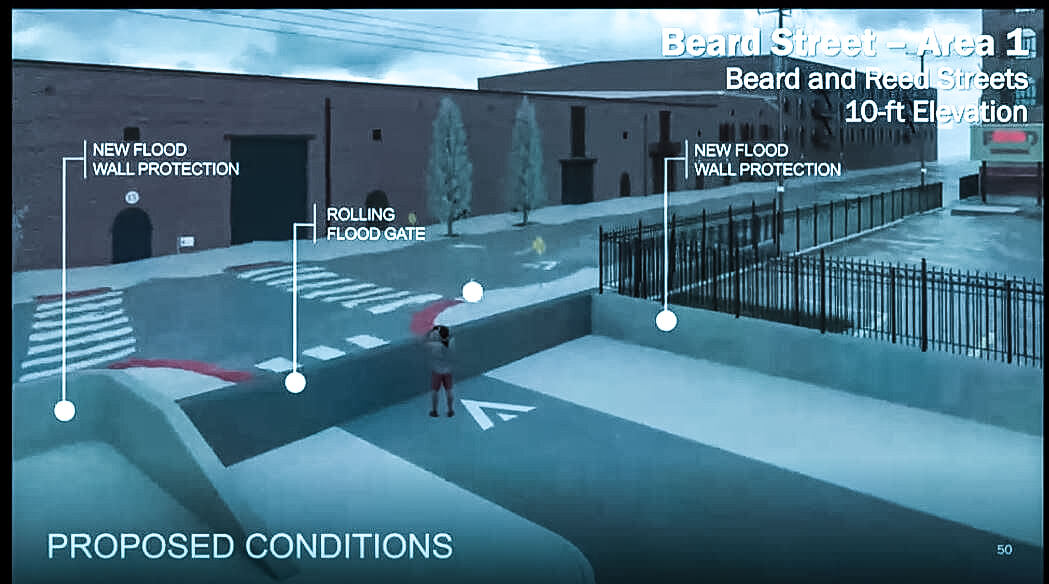Hurricane Sandy provided headline opportunities for New York’s governor, Andrew Cuomo. In January 2014, Vice President Joe Biden came to Albany to announce a statewide program to protect against natural disasters.
As the online news site Politico wrote: “The state would build a $200-million flood protection system in Red Hook, Brooklyn, an area particularly hard-hit by flooding during Hurricane Sandy, which caused an estimated $32 billion in damage when it struck in October of 2012.”
By that summer, the $200 million number was cut in half, and work was begun on a plan for submission to FEMA. Once approved, it moved to the NYC Department of Design and Construction, who presented the current state of the plan to Red Hook in an online presentation which can be seen here: https://on.nyc.gov/2ZPTS66
It was mostly a boring presentation in which their main presenter, someone named “Q” slowly went through a Powerpoint presentation, which you can see here: https://bit.ly/3bKqYak
In it, he explains the kinds of protections that can be done, without stressing the kinds that cannot.
Questions were asked and patiently answered, or in some cases not.
The most shocking part of the presentation was a video they made of Food Bazaar and its close neighbors flooding. You can see the stills above.
What would happen, according to this plan, would be that walls would be placed along Beard Street, and in a hurricane, what they call a “rolling flood gate” would be activated and keep the flooding within Food Bazaar, which is 480-500 Van Brunt Street, and the warehouses, which include 471, 481 and 499 Van Brunt. Not only would the floodwaters stay within, because they couldn’t spread out, they would rise higher than if there were no walls.
Of course you can imagine that certain people were shocked by this, including the author, whose newspaper office is located at 481 Van Brunt Street, a space shared with NY Printing and Graphics, who suffered hundreds of thousands of dollars of losses during Sandy.
Among the slides shown was one that mentioned the procedures that the Department of Design (DOD) followed in preparing their plan. It mentioned that there were meetings with community stakeholders, one of which was the O’Connell Organization, which owns the above mentioned buildings.
Gregory T. O’Connell played for me a tape of the private meeting held with DOD back in June. They basically laid out the same plan they did in October. I asked O’Connell why he wasn’t more vociferous in his objections (meaning he was very quiet and polite while laying out the concerns he had for his tenants and the community, Food Bazaar being one of only two supermarkets serving Red Hook.)
He wrote back: “Well at that point I was under the impression that these people would work with us so I didn’t think it would be helpful to get upset. There seems to be no real substance behind engagement and feedback—I get the sense those are just boxes to check for their process. They claim that FEMA requires that it be on public property but I’ve always told them we’d work with them and are open to easements etc. To date nothing has been changed and our points have been ignored.”
I asked Nydia Velazquez about this, and Dan Wiley, her District Director wrote back: “Nydia wanted me to let you know that we are doing a letter and convening a Red Hook Coastal Resiliency project follow up meeting regarding concerns with what’s left out of the plan. I’ve spoken with the Mayor’s Office of Resiliency and NYC Dept of Design and Construction and they will schedule a meeting in the next week or so with the Congresswoman and affected waterfront properties, residential and business tenants just outside the flood protection including Beard Street (and Food Bazaar) and Red Hook Terminal.
I’ve also spoken with FEMA to have a representative attend the meeting since the question on the eligibility criteria have come up with regard to key decisions on the alignment of the barrier and what was taken under consideration in due diligence.”
So there is hope still for not just some of Red Hook, but all of it. Stay tuned.
Author
-

George Fiala has worked in radio, newspapers and direct marketing his whole life, except for when he was a vendor at Shea Stadium, pizza and cheesesteak maker in Lancaster, PA, and an occasional comic book dealer. He studied English and drinking in college, international relations at the New School, and in his spare time plays drums and fixes pinball machines.
View all posts
George Fiala has worked in radio, newspapers and direct marketing his whole life, except for when he was a vendor at Shea Stadium, pizza and cheesesteak maker in Lancaster, PA, and an occasional comic book dealer. He studied English and drinking in college, international relations at the New School, and in his spare time plays drums and fixes pinball machines.













2 Comments
George- I am a bit surprised that you are reporting this as if you had not attended many Red Hook Rising public meetings as well as other public and private meetings where this was all discussed: that the flood protection plan had to be built on government owned and controlled property- Streets. I thought you were up to speed on this, years ago. Mea culpa.
I know that the O’Connell’s did not attend many of these meetings.
We have all had nine years to figure this out. major property owners have a major stake.
I find it completely disingenuous for any Red Hook resident or business owner, in 2021, to profess shock and indignation that some buildings will be on one side or another of the (still proposed) coastal protection.
Let’s get the protection that $100 million will buy- let’s get the Red Hook Houses protected. Let’s get the small business protected. Let’s get everyone we can protected.
The point of the article was that the O’Connells were consulted earlier this year, and their concerns were left unaddressed, contrary to the supposed point of stakeholder engagement.